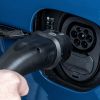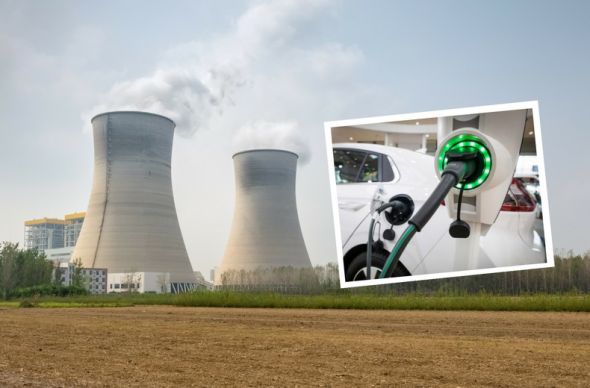Introduction
One common angle of attack concerns particulate matter, which is the very fine particles produced by petrol and diesel exhausts, tyres and brakes. Particulate matter concentrates in the air close to ground level, at child height. The smallest nanoparticles waste no time in entering the bloodstream with numerous grave health consequences, including heart attacks and strokes.
The most recent example of electric vehicles being accused of producing more particulate matter pollution than petrol and diesel cars came on the back of remarks made by Environment Secretary George Eustice to the House of Commons’ Environment and Rural Affairs Committee.
Mr Eustice said: “Some say that just wear and tear on the roads and the fact that these vehicles are heavier means that the gains may be less than some people hope.” His remarks appear to refer to claims that electric vehicles emit more nanoparticle matter pollution from their brakes and tyres than petrol and diesel cars, because EVs are heavier. This is a bold statement from the UK’s Environment Secretary, but is it true?
Brake particulate matter
Let’s first look at brakes. When slowing a car down, the brake pads are pressed against the brake discs, emitting a fine particulate matter dust in the process. While this happens with all vehicles, brake use, and therefore brake wear, on electric vehicles is substantially less than on petrol and diesel cars.
This is because, in EVs, the overwhelming majority of braking can be done via regenerative braking. This is where the electric motor works in reverse, converting kinetic energy from the moving vehicle into electricity, which is used to charge the battery when slowing down. This not only reduces the use of the mechanical brake discs and pads, but adds more range to the vehicle, too.
Such is the strength of regenerative braking that Volkswagen has switched from brake discs and pads, to brake drums, on the rear of its ID series of EVs, and on other EVs using its modular electric drive matrix (MEB) platform like the Skoda Enyaq. Most car manufacturers prefer brake pads and discs for their petrol and diesel cars because the latter is exposed to the elements and therefore dissipates heat better during repeated braking.
That same open structure means that brake pads and discs are also effective at releasing particulate matter pollution into the environment during use. However, EVs make so little use of their brakes that heat build-up is not an issue, thus allowing brake drums to be used successfully. Since brake drums are enclosed, any particulates from their use aren’t released into the environment, meaning that what little use the drum gets doesn’t contribute to particulate matter pollution.
- Everything you need to know about brake pads
- Stopping distances made simple
- Electric car leasing explained – EV financing vs buying
EV brake pad lifespans of up to 100,000 miles
High mileage electric vehicle fleets across the country will testify to the reduced wear and increased lifespan of brakes on EVs compared to those on petrol or diesel vehicles. A perfect place to start is in Dundee, a city that has thoroughly embraced EVs. Ryan Todd, director of Dundee Taxi Rentals – one of several electric taxi fleet operators in the city – notes that his 11 electric Nissan Leaf taxis typically have a brake pad lifespan of 80,000 to 100,000 miles, with discs typically being changed because of warping rather than wear.
Those brake pad and disc lifespans are four times and two times those of the brakes on his diesel taxis, respectively, and that’s on a type of vehicle that is known to be driven with little thought given to brake wear or efficiency. Such is the reduction in particulate matter from EVs versus diesel cars – not just from brakes, but from exhaust emissions too – and such is the extent that Dundee has embraced electric taxis, cars, buses and vans, that in 2018, Dundee city centre met key air quality targets for the first time, as a direct result of the city’s switch to EVs.
Unsurprisingly, the same increase in brake lifespan has been found on other electric vehicles too. Cleevely EV, one of the best-known EV mechanics in the UK based in Cheltenham, regularly sees EVs with brakes that have lasted over 100,000 miles. Cleevely EV notes that they typically have to replace EV brakes not because of wear, but because they’ve seized up due to lack of use.
A testament to this is Cleevely EV’s own mobile mechanic service, which consists of a fleet of electric vans that have been known to regularly cover in excess of a thousand miles per week. Their top mechanic James Coates estimates that their brake pad lifespan will be 100,000 miles, with the discs likely to remain unchanged unless they become corroded.
RAC Breakdown Cover
Join the RAC and get breakdown cover. Our patrols fix 4 out of 5 vehicles on the spot, with repairs done in just 30 minutes on average.


Tyre particulate matter
Another source of particulate matter pollution from EVs is from tyres. As the tread on tyres wears down, tiny nanoparticles of rubber are cast off onto the road and into the atmosphere near ground height.
A press release by Emissions Analytics suggested that particulate matter pollution from car tyre wear can be 1,000 times higher than car exhaust emissions, and that car tyres may produce as much as 9.28 grams of particulate matter per mile, or 5.8 grams per kilometre. This is, however, a worst-case scenario – a crucial point that is not mentioned in the press release and which has consequently led to the ‘1,000 times higher than car exhaust emissions’ finding being widely reported in the media. Some common-sense calculations show how extreme this case is.
A typical 16” family car tyre weighs around 9 kg, so four of them on a vehicle gives a total weight of 36 kg. That’s not just the tread, but the full tyres. If a car did shed 9.28 grams of particulate matter per mile from the tyres, then the car tyres would physically disappear – and the car would be running on its alloys – in less than 4,000 miles.
In reality, the tread of a tyre is about 35% of the tyre’s total weight, so the tyres would be bald in less than 1,358 miles, or two months’ worth of driving for the average UK driver.
So, we now know that tyre wear is nowhere near as big a contributor to particulate matter emissions as some media coverage has suggested in the past. However, if electric vehicles are heavier than petrol or diesel cars, do they wear out their tyres faster? Firstly, modern electric vehicles aren’t actually that much heavier than many modern petrol or diesel cars, especially with the recent trend towards bigger and heavier SUVs.
- Tyre tread depth and tyre safety checks
- How to get more from your tyres
- How long do electric car batteries last? EV battery recycling
- Exhaust repairs
Battery chemistry is continuously evolving, getting lighter and more “energy dense,” i.e. able to squeeze more miles of range into the same weight and volume of battery pack. Such is the energy density of modern EV batteries – most new EVs on the market have a range of 200 miles or more - that very soon we will likely start to see a move away from stuffing more battery capacity into the same space, towards offering the same capacity but in a lighter, cheaper battery, resulting in a lighter, cheaper car.
15,000 electric miles without new tyres
As for the EVs on the road today, their tyre wear is nowhere near as accelerated as some naysayers suggest. James Rooney, fleet engineer at British Gas, an operator of 800 electric vans (soon to be thousands) of electric vehicles, notes that their latest electric vans – which are large, heavy vehicles with traditionally tyre-chewing front wheel drive – have done 15,000 miles and not needed tyres or brakes replaced yet (with the exception of punctures, of course).
Ryan Todd has noticed something interesting about tyre wear on his taxis. When his Nissan LEAF electric taxis are delivered to him brand new, they are typically fitted with a high quality make of tyre like Michelin. The tyres usually last between 30,000 and 36,000 miles on the rear wheels, with the fronts lasting 20,000 miles.
While it is typical for front tyres to have shorter lifespans than rear tyres, Ryan notes that his diesel taxis do tend to get an extra 5,000 to 10,000 miles of lifespan out of their front tyres. This is because the LEAF is not only front wheel drive – so the front tyres are doing the steering as well as propulsion – but has a lot more torque from its motor than a diesel car, resulting in increased wear over time. If cheaper replacement tyres are fitted to his diesel or electric taxis, their lifespan of all four tyres is typically reduced by about 5,000 miles versus the original high-quality tyres – an important lesson for any vehicle driver.
Ryan notes, however, that the 30,000 to 36,000-mile lifespan of the rear tyres on his LEAF taxis is about the same as the rear tyres on his diesel taxis, since they aren’t propelling or steering the vehicle.
If driven more leisurely, as per most cars, the lifespan of the front tyres on his electric taxis would likely increase. Given that the taxi and van fleets mentioned above are examples of fleets that are likely driven a little more harshly than the average car, the fact that they have such vastly reduced brake wear, and similar tyre wear on the rear wheels in particular, bodes very well for controlling particulate matter pollution.
Remapping the throttle of EVs to reduce the aggressiveness of the power delivery, or driving them in eco mode, will also help to extend tyre lifespan on more harshly driven vehicles. Plus, as Dundee has already shown, air quality is demonstrably better in cities that have high uptake of electric vehicles, due to a substantial net reduction in particulate matter from exhausts, tyres and brakes.
Furthermore, Cleevely EV Mobile’s high-mileage cross-country electric vans, show that the tyre lifespan of front-wheel drive EVs can be just as good as petrol or diesel cars. James notes that his MG5 EV, which is only four months old, is approaching 20,000 miles on the clock, and all tyres have plenty of tread left on them. A veteran mechanic with an accurate judgement of component wear and remaining lifespan, James reckons he’ll get 30,000 – 35,000 miles out of all four tyres.
Additionally, many tyre manufacturers are developing special tyres for electric vehicles, which provide greater efficiency and less wear without sacrificing grip. This includes both big name tyre brands and new companies, like Enso, that have been set up specifically to tackle pollution from tyres.
Conclusion
So, in conclusion, electric vehicles already vastly reduce particulate matter from brake wear, and claims of tyre wear contributing 1,000 times the particulate matter pollution of petrol and diesel exhausts are greatly overexaggerated. Real EV fleets are already seeing brake lifespans increased fourfold versus the diesel vehicles they have replaced, and tyre wear that is broadly on par with petrol and diesel cars (unless, as like with any vehicle, the drivers get a bit throttle happy!).
One final thought on emissions to end with: the UK is set to close its last remaining coal-fired power plants, but even if EVs were 100% powered by coal, it is much easier to fit particulate filters to a small number of very large, static power plants located away from city centres, than it is to fit effective filters to millions of small, mobile petrol and diesel engines running in urban areas.
The end result is that cities that have embraced EVs have already demonstrably benefitted from reduced pollution and improved air quality, and this trend shall only continue as more EVs switch to drum brakes, new tyres are developed that reduce nanoparticulate pollution even further, and the UK’s grid becomes ever increasingly powered by clean renewable energy.
Install a home charging point
Going electric? Installing a home charging point makes owning an electric car so much easier and cheaper.


Need your brakes repaired?
RAC Mobile Mechanics offer maximum convenience and can replace your brakes on your doorstep.









